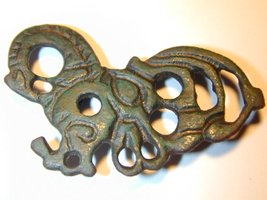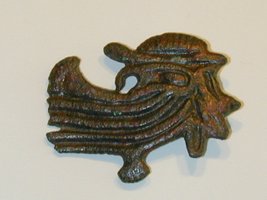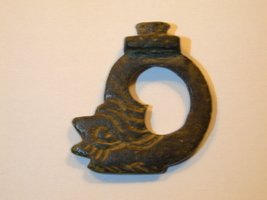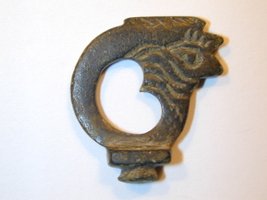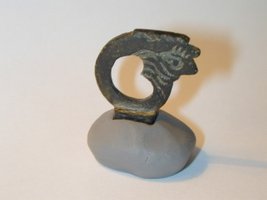The hidden ones in Viking-Age artefacts - they appeared everywhere..
This week's blog is a guest blog, written by David Mullaly from the U.S.
Now retired, his recent and long-term buying and selling experience has allowed him to see close up some remarkable Viking Age artefacts, a few of which are discussed here.
The hidden face motif.
Vikings loved gold and silver because they could buy power, and because wearing items made from those precious metals suggested high status for warriors or their women. However, archaeologists and collectors also understand that the Scandinavians and those influenced by them were delighted by visual stimulation. At its simplest, Vikings loved glitter or bling: light reflected off of irregular surfaces. That might help to explain why Viking decoration frequently involved a myriad of punches and elaborate etching. However, there was clearly an appetite as well for decorative items which encouraged the observer to see different objects or faces. This is sometimes called the “hidden faces” motif.
Animals and a helmeted man..
The first example, illustrated in Benet’s Artefacts of England and the United Kingdom (p.317) is an extremely rare and fairly abstract form of Viking bronze brooch, found in Suffolk, which seems to show a dragon’s or horse’s head and arched neck, a bird’s head, and if you look carefully, a helmeted man’s head—the man seems to be laughing. Clearly, the brooch was intended to simultaneously offer multiple things, depending on how the piece was viewed.
Odin in disguise
The second example, at first glance, appears to be a strange man’s head, facing to the right, although it looks almost as much like a duck as a man. Found in Lincolnshire, this wonderful brooch doesn’t allow you to accept that view without looking further. At some point, you realize that there is another head, this one facing to the left, which has the lower part of the face hidden by long, flowing hair. You see a floppy hat, then an eye and an empty eye socket peering at you, and finally you realize that you are looking at the face of the one-eyed god Odin. The brooch offers you first a cartoon-like face, and then an obscured portrait of the most powerful Viking god.
Finally, you need to look at the picture of a “hidden faces” object which was actually never intended to disguise anything.
This item, found on the shore of Lough Neagh, a large lake in Northern Ireland, was offered for sale using a picture like this, and the seller suggested it was Viking and showed “a fish of some sort.” However, the tab at the top of the picture reveals something very different. Clearly, the shape of it indicates that it was intended to be permanently imbedded in some material, and not removed, so let us invert the picture.
The King piece ?
Now, one can see a profile head with the long lines of hair obscuring the bottom of the face—like the previous brooch. Is that a helmet with a crest on top, or a crown? The same hand etched design is on both sides of the piece, which indicates that this was a game piece, presumably a “king piece” (the only specially marked piece) for a Viking Hnefatafl game. The base was probably a simple lump of lead, which was lost centuries ago. See the final picture.
There are very few definite examples of Hnefatafl king pieces to be found anywhere, so this is an extraordinary understated little find. Many rounded pieces of lead have been found with low profile items—coins, bits of gilded and chip-carved bronze, pieces of glass—and Viking collectors have wanted to believe that these were Hnefatafl “king pieces.” They may be correct, but that is still conjectural; many were probably decorated trade weights. This piece seems to be the real thing.
Well. I could have been with these stones until after dark, but as my wife wanted to travel on.. well.. I see you again, some day, hogback stones from Gosforth. And if you happen to be there one day, do not forget that monument on the outside...
Further on with the Cumbrian hogbacktour !
In - yes, luckily again in - St. Peter's church in Heysham, there is a truly beautiful hogback stone. The guide told us, it had been studyied by Thor Ewing, a writer, in 2000. in 'Understanding the Heysham hogback' A tenth century sculpted stone monument and its context (link), Thor Ewing tells in detail what he dicovered on the both sides of this hogback stone.
Just being brought in the church as late as the 1970's accompanied with some protest here and there among the church visitors, considered as being a token of old paganism, it had been remarkably nice preserved, and a lot of detail can be seen, still. Truly worthwile a visit.
I had a small debate with the guide in the church if the - zoomorphic, in my opinion - faces on the sides were lions (or hippo's). The guide doubted if the vikings could have known about lions. Well I guess so, concerning the runes on the Ancient Greek lion statue at the Arsenal, Venice. For example. Vikings did travel south..
But when he told me he was doubting the vikings 'discovered' (as the native inhabitants were of course, in the first place) America before Columbus, I decided to rest my case..
One has to know when to start and to end a conversation ..
Just discovered the book in a bookstore written by Geoff Holder - The guide to the mysterious Lake District, I knew there had to be another hogback stone in Lowther, St. Micheal's Church. With a promising image described in the text of 'a naval and a land-based force of shield-bearing vikings above a fish and what might be a coiled sea serpent. On the reverse is a row of female figures with snakes, possibly a representation of the hideous hag Hel'. Wow. If that did not sound as a true pagan promised land ..
Not complaing too much after all we have seen, this visit was the dissapointing one of them all. But if you wife states 'I am happy to have seen them' and I am answering 'Measuring is knowing' and the even more obligate verb 'handling 'if we did not see it at all, we wouldn't have known anything at all of how they were looking' the glass was again half full, at the last day of our journey..
The hogback stone appeared to be just being tolerated within the entrance segment part of the church. As something you never use anymore but you do not throw away - entirely. That sort of feeling emerged when seeing this hogback asylum seekers.. Bed, bath and bread, ás we say in Dutch, but no luxury at all and standing on some outcuts of wood, you would balance the table with at home..
Come on, St. Micheal's Church.. care a bit more of your 'children' !
This hogback stone was moved in the church in 1907. Hogback stones layed partially buried in the churchyard before it was dug up and moved into the church.
The promising depiction of a longship - as certainly can be seen after some studying - see http://vikingminds.co.uk/pages/longship
we have missed !
The stone itself is (157 x 50 x 30 cm) and very worn.
The hogback stones in Cumbria - very diverse in quality, but everyone worth a visit ! Especially on a gloomy day in late October ...
The churches to visit - see photos of resp. St. Andrew's church in Penrith, St. Mary's church in Gosforth, St. Peter's church in Heysham and St. Micheal's church in Lowther.
Did I miss out on another one in Cumbria ? Let me know !
In a next blog I will take you to four - still remaining utterly mysterious- statues 'guarding' the graveyard of St. Andrew's church in Dacre..
For the last blog of October 9th see this link.
References: (as always, links to where the books can be ordered are attached).
Edwards, B.J.N. Vikings in North West England - The artifacts (1998);
Emery, Gordon, CURIOUS CUMBRIA, The Lake District & Beyond: A celebration of Cumbria (2023)
Ewing, T. 'Understanding the Heysham hogback' A tenth century sculpted stone monument and its context ;
Hall, R. Viking Age archaeology in Britain and Ireland (first printed 1990, reprinted with amendments in 1995);
Holder, G. The guide to the mysterious Lake District (2009)
possibly also (as there within the part of Cumbria dealing with Carlisle, the Eden Valley, Barrow-in-Furness, Whitehaven and the west coast is being dealed with)
Holder, G. Paranormal Cumbria (2010)
http://vikingminds.co.uk/pages/longship
